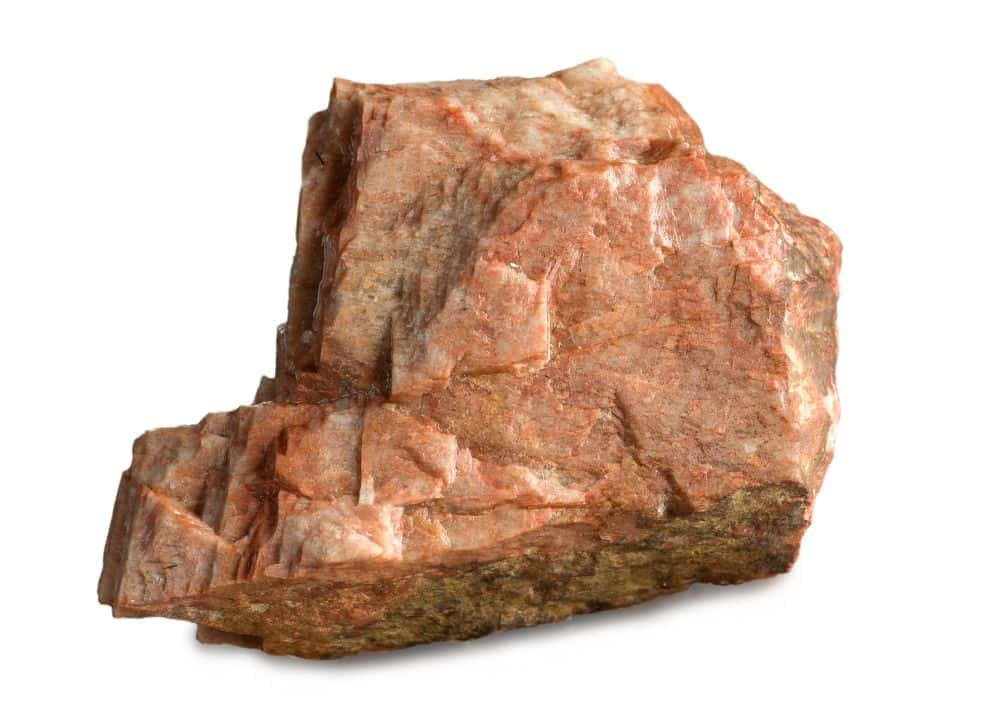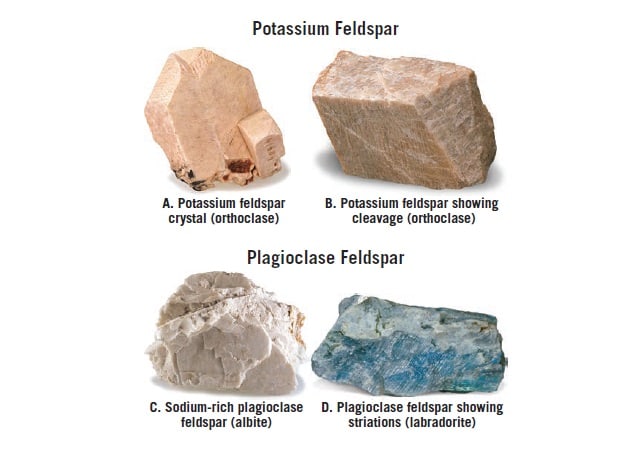
Feldspar, a term encompassing a group of abundant rock-forming minerals, plays a pivotal role in shaping our planet’s geology. These minerals are integral to the formation of a vast array of types of rock. Feldspars also have distinctive properties that make them valuable in various industrial applications.
What is Feldspar?
Feldspar refers to a group of aluminum tectosilicate minerals. It contains a mixture of sodium, potassium, calcium, and barium, arranged in a variety of crystal types.
Feldspar plays a key role in forming and shaping many of the Earth’s many rock types. Feldspar minerals constitute about 60% of the crust. They are the primary components in the genesis of igneous rocks such as granite and basalt. Their presence is also notable in metamorphic rocks, where they can provide vital clues about the conditions and processes that led to the rock’s transformation. In sedimentary rocks, feldspars offer clues to the sediment’s origin and the environmental conditions during its deposition.
Feldspar minerals are stable at high temperatures and pressures, making them integral to the crystallization processes within the Earth’s mantle. As magma cools, either beneath the surface in intrusive formations or after erupting as lava in extrusive formations, feldspars are often among the first minerals to crystallize. This early crystallization can significantly influence the composition and texture of the resulting igneous rock.
Feldspar Mineral Properties
| Property | Description |
|---|---|
| Color | Varied (white, pink, tan, green, grey) |
| Hardness | 6-6.5 on Mohs scale |
| Luster | Glassy or pearly |
| Cleavage | Two directions of perfect cleavage at nearly 90° |
| Specific Gravity | Approx. 2.55-2.76 |
| Transparency | Transparent to opaque |
| Chemical Composition | 6-6.5 on the Mohs scale |
Feldspars have a unique set of properties that are influenced by their chemical composition and crystalline structure. These minerals display a diverse color palette, ranging from shades of white and pink to tan, green, and grey. The specific hues are often determined by the mineral’s chemical makeup and the presence of impurities.
The hardness of feldspars typically falls between 6 and 6.5 on the Mohs scale, making them relatively resistant to scratching by softer materials. They commonly exhibit a glassy or vitreous luster, though a pearly sheen can also be observed on their cleavage faces.
Speaking of cleavage, feldspars are renowned for their two directions of perfect cleavage that meet at nearly right angles. This is another feature that significantly contributes to their recognizable appearance.
The specific gravity of these minerals varies, approximately lying between 2.55 and 2.76. Feldspars also range in transparency from completely transparent to entirely opaque. The transparency is influenced by the feldspar composition and any impurities they may contain.
Crystal structure of Feldspar
The crystal structure of feldspar is that of a tectosilicate, with a framework composed of silicon and oxygen tetrahedra. Each tetrahedron includes a central silicon or aluminum atom surrounded by four oxygen atoms, connected by shared oxygen atoms. This creates a three-dimensional framework that accommodates various cations like sodium, potassium, calcium, and barium, resulting in different feldspar types.
The specific arrangement of these tetrahedra and the placement of cations define the individual properties of each feldspar mineral.
Types of Feldspar

Feldspars are primarily classified into two major groups based on their chemical composition and crystal structure — potassium feldspar and plagioclase feldspar.
Plagioclase Feldspar
This group represents a continuous series of solid solutions between the end members albite (sodium-rich) and anorthite (calcium-rich). Plagioclase minerals are characterized by their triclinic crystal structure and are commonly identified by their striations on cleavage faces, a feature not seen in alkali feldspars. They range in color from white to gray and can be distinguished based on their varying composition.
Some notable examples of plagioclase feldspars include:
- Albite (NaAlSi3O8): Sodium-rich, it is typically white or translucent.
- Oligoclase: Has more calcium than albite but less than andesine.
- Andesine: A balance of sodium and calcium.
- Labradorite: Richer in calcium, known for its iridescent play of colors.
- Bytownite: Closer to the anorthite endmember, with high calcium content.
- Anorthite (CaAl2Si2O8): The calcium-rich endmember, often white or grayish.
Alkali Feldspar
This group consists of potassium and sodium feldspars with a monoclinic or triclinic crystal system. The alkali feldspars are significant for their presence in granite and other felsic igneous rocks. Common members include:
- Orthoclase (KAlSi3O8): Potassium-rich, typically displaying a salmon pink to white color.
- Microcline: Similar in composition to orthoclase but with a triclinic crystal structure, known for its grid-like patterning.
- Sanidine: High-temperature potassium feldspar, commonly found in volcanic rocks.
- Anorthoclase: A sodium-rich alkali feldspar with properties intermediate between albite and orthoclase.
Both plagioclase and alkali feldspars are critical in petrology for classifying igneous rocks. The relative proportions of these feldspars, along with other minerals like quartz, are used in the QAPF diagram.
| Feature | K-Feldspar | Plagioclase Feldspar |
|---|---|---|
| Chemical Composition | Primarily potassium-aluminum silicates (KAlSi3O8) | Sodium to calcium aluminum silicates (NaAlSi3O8 to CaAl2Si2O8) |
| Crystal System | Monoclinic or triclinic | Triclinic |
| Cleavage | Two directions, nearly at right angles | Two directions, nearly at right angles, often with striations |
| Hardness (Mohs Scale) | 6 – 6.5 | 6 – 6.5 |
| Color Variations | Typically white, pink, or cream; can also be green or gray | Typically white to gray; can also be blue, green, or red |
| Streak | White | White |
| Luster | Pearly to glassy | Pearly to glassy |
| Specific Gravity | Approx. 2.55 – 2.76 | Approx. 2.62 – 2.76 |
| Occurrence in Rocks | Common in granite, pegmatites, and metamorphic rocks | Common in basalt, gabbro, and andesite |
| Twinning | Rare | Common, often seen as striations on cleavage faces |
| Optical Properties | Shows birefringence under polarized light | Shows polysynthetic twinning under polarized light |
| Weathering Resistance | Relatively resistant but less so than quartz | More prone to chemical weathering than K-feldspar |
Feldspar Occurrence
Feldspars, as the most abundant group of minerals in the Earth’s crust, display a wide range of occurrences across various geological settings. Their presence is not only pervasive but also indicative of the geological history and processes of the regions where they are found.
Igneous Rocks
Feldspars are primary constituents in both intrusive and extrusive igneous rocks. In intrusive igneous rocks, such as granite and syenite, feldspars often crystallize from magma deep within the Earth’s crust. They are key in defining the texture and composition of these rocks. In extrusive igneous rocks like basalt and rhyolite, feldspars crystallize from lava at the Earth’s surface. The rapid cooling associated with extrusive formation typically results in smaller crystal sizes.
Metamorphic Rocks
Feldspars are also present in metamorphic rocks, which form under the influence of high pressure and temperature that alter the original rock’s mineralogy and structure. In metamorphic settings, feldspars can either be inherited from the precursor rocks or form as new minerals during the metamorphic process. Common metamorphic rocks containing feldspars include schist, gneiss, and amphibolite.
Sedimentary Rocks
While less common in sedimentary rocks compared to igneous and metamorphic rocks, feldspars do occur in various sedimentary environments. They are typically present in clastic sedimentary rocks, such as sandstone and arkose, where they are components of the detrital grains. Feldspars in sedimentary rocks often indicate minimal transport or rapid deposition, as they are prone to chemical weathering at the Earth’s surface.
With Other Minerals
Feldspars commonly coexist with quartz, mica, and various other minerals. In granite, for example, feldspars are typically associated with quartz and biotite mica. These associations are important in understanding the crystallization sequence and the physicochemical conditions during the rock formation.
Feldspar Uses
The uses of feldspars range from everyday items to specialized industrial and scientific applications, underlining their versatility and importance.
Glass Production: In the glassmaking industry, feldspars are prized for their alumina and alkali content. They act as fluxes that lower the temperature at which the mixture melts. Feldspars also contribute to the strength and durability of the glass.
Ceramics Industry: Feldspars are a critical ingredient in the ceramics sector. They provide the necessary fluxing agents that facilitate the firing process, leading to the formation of a glassy phase that binds the other components together. Feldspars are involved in the production of tiles, sanitary ware, tableware, and electrical insulators.
Fillers in Paint and Plastics: Due to their chemical inertness and relative abundance, ground feldspar is used as a filler in paint, plastics, and rubber. This enhances the durability and performance of these products.
Abrasives: The hardness of feldspar makes it useful as a mild abrasive in some industrial and household cleaning products. It can gently polish surfaces without causing significant damage.
Earth Sciences: Feldspars are pivotal in geological and archaeological research. They are used in radiometric dating methods, like potassium-argon and argon-argon dating, to determine the age of rocks and archaeological materials. This has profound implications for understanding geological time scales and human history.
Landscaping and Decorative Aggregates: The aesthetic appeal of certain types of feldspar, such as those with a play of colors or unique crystal formations, makes them popular in landscaping and as decorative aggregates.
Agriculture: Some feldspars, when ground into a fine powder, are used in certain agricultural applications, primarily as a source of nutrients and as a soil conditioner.
Feldspar’s widespread presence and its multitude of uses underscore its significance not just in geology but also in many facets of modern life. It’s one of the most impactful minerals and a staple in geology.






